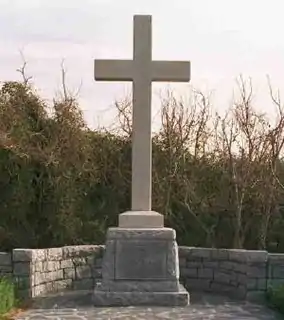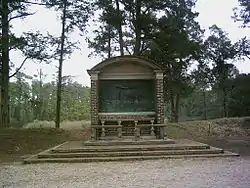Robert Hunt (chaplain)
Robert Hunt (c. 1568x1570 – 1608), a vicar in the Church of England, was chaplain of the expedition that founded the first successful English colony in the New World, at Jamestown, Virginia, in 1607.
Career in England
Hunt was born in Hoath, near Reculver, in Kent, England, in the late 1560s or early 1570s.[1][2] He was vicar of Reculver from 18 January 1594 until he resigned and was replaced on 5 October 1602.[3] He was forced to leave his wife Elizabeth Edwards and two children Thomas & Elizabeth there in disgrace then, because of his wife's adulterous "seeing too much of one John Taylor".[4][5][6] In 1606, he was forced to leave his second parish, at Heathfield, in Sussex, when he was accused of having his own adulterous affair with his servant, Thomasina Plumber, as well as "absenteeism, and neglecting of his congregation".[4][7][8][9]
"Joining" the Virginia Expedition
Summoned to London, Hunt was "recruited" by Richard Bancroft (the Archbishop of Canterbury), along with Richard Hakluyt, Jr. (the geographer and priest) and Edward Maria Wingfield, as chaplain for the newest expedition to the New World by the London Virginia Company.[7][10] Hunt sailed with his fellow colonists aboard the Susan Constant (helmed by Captain Christopher Newport).
Cape Henry: First Landing

On 26 April 1607, after an unusually long voyage of 144 days, the three ships and 105 men and boys made landfall at the southern edge of the mouth of the Chesapeake Bay at the Atlantic Ocean. They named the location Cape Henry, in honour of the young Henry Frederick, Prince of Wales, eldest son of their king.
There, Hunt led what was likely the first protestant sermon in America since Sir Francis Drake's landfall at California in 1579, planting a cross at the site. Today, a memorial stands at the location at Joint Expeditionary Base East, near what has become the aptly named First Landing State Park in the current independent city of Virginia Beach, Virginia.
Jamestown
Within a few weeks, the settlers chose a permanent inland site for their colony on the James River, naming it Jamestown in honor of King James I. The location was selected as ordered by the sponsors in London with a priority of being a strategic defensive position against possible attacks by ships of competing European factions. However, this came at a terrible price, as Jamestown Island combined swampy and mosquito-infested land, offering poor hunting and little room for farming with brackish tidal river water and no fresh water springs. While conflicts with the other Europeans never became a problem, getting along with the Native Americans, and even more importantly, with each other almost immediately became major issues for the ill-prepared colonists. Captain Newport soon left to hurry back to England to bring more supplies and replacement colonists. Newport eventually did so three times, twice without mishap, and lastly on the ill-fated Sea Venture, flagship of the Third Supply mission. However, when he left the first time, they were left alone at Jamestown with only the tiny Discovery, so there was no turning back.
Despite the incredibly onerous circumstances of the Jamestown mission's beginnings, Rev. Hunt seemed to rise to the occasion, often mediating disputes between the camp's various factions, smoothing "ruffled feathers" and making peace. He was described by Wingfield as “a man not in any way to be touched with the rebellious humours of a popish spirit, nor blemished with the least suspicion of a factious schismatic, whereof I had a special care”. On 21 June 1607, Rev. Hunt "celebrated [probably] the first known service of holy communion in what is today the United States of America."[11]
Legacy

Today, a shrine sits on the site at the National Park Service's Historic Jamestowne attraction of the Colonial National Historical Park on Jamestown Island. The shrine replicates the outdoor chapel conditions under which he spiritually led the men and boys, most of whom were to die, as did Chaplain Hunt, during the first year. The shrine honours Hunt for his self-sacrifice and leadership in the first, most difficult times for the colony.
Its inscription reads:
- "Our factions were oft qualified, and our wants and greater extremities so comforted that they seemed easie in comparison of what we endured after his memorable death...."
Hunt is honored with a feast day on the liturgical calendar of the Episcopal Church (USA) on 26 April.
Archaeological discovery
In July 2015, Smithsonian Institution forensic anthropologists confirmed that remains they had found buried in a church in Jamestown, Virginia, belonged to Hunt.[12][13]
See also
- Historic Jamestowne operated by National Park Service
- Jamestown Settlement operated by Commonwealth of Virginia
- Jamestown Rediscovery project of archeological work by Association for the Preservation of Virginia Antiquities
- Jamestown 2007 celebrating 400th anniversary
References
Notes
- "The Reverend Robert Hunt: The First Chaplain at Jamestown". nps.gov. Retrieved 28 July 2015.
- Gough 1984, p. 21.
- Duncombe 1784, p. 155.
- "Robert Hunt". Oxford Dictionary of National Biography (online ed.). Oxford University Press. doi:10.1093/ref:odnb/14202. (Subscription or UK public library membership required.) Retrieved 21 April 2014.
- Withington, Lothrop, Virginia gleanings in England: abstracts of 17th and 18th-century English wills and administrations relating to Virginia and Virginians: a consolidation of articles from The Virginia magazine of history and biography, Baltimore: Genealogical Publishing Co., Robert Hunt's will (signed 20 November 1606 and proved 14 July 1608): "... To Elizabeth my daughter, 30 pds. to be paid when she shall come to eighteene yeares. ... To my sonne Thomas 10 lbs. to be paid at the age of one and twenty years. ... brother Steven Hunt, now or late of Reculver."
- Several unreferenced sources list William as the first child of Robert Hunt and Elizabeth Edwards.
- Wingfield, Jocelyn, Virginia's True Founder [2007], p. 163. ISBN 1-4196-6032-2
- Renshaw, W. C., Notes from the Act Books of the Archdeaconry Court of Lewes in Sussex Archaeological Collections, vol. 49 sub: Bancroft [1906].
- q. in Benjamin Woolley, Savage Kingdom [2007], p.36 & n.16.
- Renshaw, W. C., Notes from the Act Books of the Archdeaconry Court of Lewes in Sussex Archaeological Collections, vol. 49 [1906], q. in Woolley,Savage Kingdom [2007], p.36 & n.16.
- "Hunt, Robert (1568/9–1608)". Oxford Dictionary of National Biography (online ed.). Oxford University Press. doi:10.1093/ref:odnb/14202. (Subscription or UK public library membership required.).
- "Smithsonian Science News –Page not found - Smithsonian Science News -". Smithsonian Science News -. Retrieved 28 July 2015. Cite uses generic title (help)
- "Remains of English Jamestown colony leaders discovered". BBC News. Retrieved 28 July 2015.
Bibliography
- Duncombe, J. (1784), "The history and antiquities of the two parishes of Reculver and Herne, in the county of Kent", in Nichols, J. (ed.), Bibliotheca Topographica Britannica, 18, Nichols, pp. 65–161, OCLC 475730544
- Gough, H. (1984), "The cure of souls at Hoath", in McIntosh, K.H.; Gough, H.E. (eds.), Hoath and Herne: The Last of the Forest, K. H. McIntosh, pp. 19–23, ISBN 978-0-95024-237-8
- Smith, Charles W. E. (1957), Robert Hunt vicar of Jamestown, Episcopal Church National Council, OCLC 4753411
External links
- Robert Hunt's biography A brief, but well referenced, biography hosted by the National Park Service.